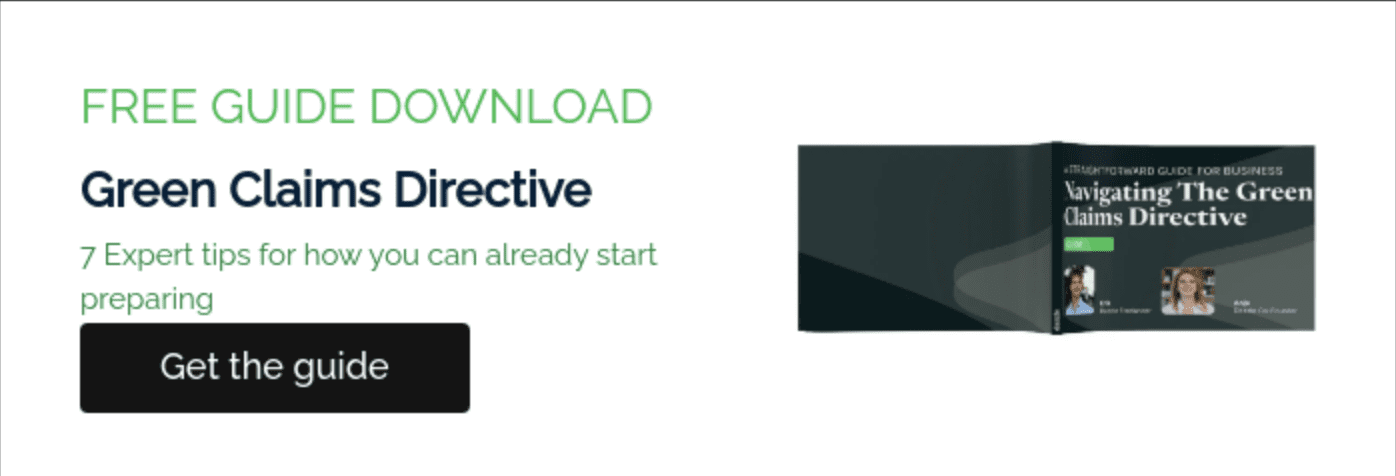About the author
Erik is a Dazzle freelancer. That means he’s been through our vetting process, and is part of our exclusive community of top-tier sustainability professionals. His main professional interest is how businesses can provide evidence for their impacts.
In the past eight years, Erik has worked with various methods that allow companies to assess their impacts, such as LCA, full-cost accounting, circular economy metrics, and social impact indicators.
Let’s face it, the marketplace is a jungle of green claims, some legit, others… not so much. With studies revealing a hefty chunk of these claims are misleading or unfounded, it’s no surprise the EU decided to step in with the Green Claims Directive.
(A European Commission study from 2020 found that 53.3% of the environmental claims they examined were vague, misleading, or unfounded, and 40% were completely unsubstantiated. Consumer trust in environmental claims is extremely low).
The goal of the Green Claims Directive? To ensure that when companies claim a product is green, that it truly is. Thereby helping consumers make informed decisions, and businesses who make genuine eco-efforts stand out. According to the EU, this will help to boost the competitiveness of businesses that are striving to increase the environmental sustainability of their products and activities.
In this article, Dazzle freelancer Erik Roos Lindgreen, an LCA (Life Cycle Assessment) specialist, helps us to understand the ins and outs of the directive. Breaking down the directive in a way that’s digestible for all of us — especially those of us without a PhD in sustainability or communications!
Breaking it down: what the directive entails
In a nutshell, the Green Claims Directive is the EU’s answer to greenwashing, aiming to make environmental claims on products and services as transparent and trustworthy as possible.
At its core, the directive mandates companies to back up their green claims with solid evidence, using scientific knowledge and a life-cycle perspective (more on that later).
It’s about adding credibility to claims and giving them a solid foundation. Think of it as the directive putting up guardrails, guiding businesses on how to communicate their sustainability achievements without falling into the greenwashing pitfall.
The directive isn’t just about penalizing misleading claims; it’s also about guiding companies with genuine sustainability efforts on how to communicate their initiatives effectively.
Navigating challenges
Businesses are imposed with the big task of correctly assessing, presenting and hopefully improving their environmental performance.
While the directive recommends a life-cycle approach for impact assessment, indirectly referring to methods such as LCA, no specific guidance on how such methods should be applied is provided, and no concrete guidance on how to communicate their results are given. This is still a complicated and context-specific task, which will be the responsibility of businesses themselves.
Another challenge is that social impacts are currently not part of the Green Claims Directive; however, they are covered by the Directive on Empowering Consumers for the Green Transition (ECGT). Companies will need to invest time and resources into understanding and applying relevant methods.
Opportunities knocking at your door
Sure, the directive poses challenges, especially for companies just dipping their toes into sustainability waters. Yet, it’s packed with opportunities.
For one, it paves the way for more reliable and comparable green claims across the board, boosting consumer trust and, ultimately, loyalty. Plus, it encourages businesses to take a closer look at their environmental impact, potentially uncovering ways to improve and innovate.
Getting your business directive ready
So, what’s the game plan for businesses regarding the Green Claims Directive?
1. Start by getting a bird’s-eye view of your environmental and social sustainability performance.
2. Identify hotspots for improvement.
3. Embrace life-cycle assessment methods.
4. Refine how you communicate your sustainability journey.
It’s not just about avoiding penalties; it’s about seizing the opportunity to lead in sustainability and build a brand that resonates with today’s eco-conscious consumers.

Life cycle assessments explained
A life cycle assessment (LCA) is a systematic analysis of the environmental impacts of a product or service throughout its entire life cycle, from raw material extraction to disposal. LCAs are important for identifying impact hotspots and informing strategic decisions to reduce environmental footprints.
By understanding where the most significant impacts occur, businesses can make targeted improvements, enhancing both their sustainability performance and their credibility.
The application of the rules that have been put forward in the Green Claims Directive offers a range of co-benefits and opportunities for businesses. Both those that have already started to embed sustainability as a core part of their strategy, and those that are planning to do so.
A few key takeaways from the directive
When claiming the environmental sustainability of a product, service, or company, businesses should:
- Specify if the claim concerns the whole product or part of it, or if the claim concerns all activities of a company or only some of them.
- Base the claim on widely recognized scientific evidence, using accurate information and international standards.
- Take a life-cycle perspective in assessing the impact.
- Take all the significant environmental aspects and impacts into account to assess the environmental performance.
- Have any claims and labels checked by an independent and accredited verifier.
Some parting words
Whenever you’re making any environmental claims, you should always specify, substantiate, and be transparent about these claims.
And remember, the Green Claims Directive isn’t just about avoiding the no-nos. It’s about embracing a more informed, evidence-based approach to sustainability. The directive is your ally, guiding you toward clearer, more credible green communications. Here are some key things to remember:
1. Go beyond just thinking about communication of your impact; but start thinking about the impact itself.
2. Start with taking a bird’s eye view of your environmental and social sustainability performance.
3. From these, ask where the hotspots are.
4. Find ways to inventory your materials and energy use.
5. Start applying conventional methods such as LCA.
6. Think about your message: how do you convince your customers that you are continuously improving?
7. Not only hire consultants for this but assure that knowledge transfer takes place.
Conclusion: your next steps
With the introduction of legislation like the Green Claims Directive, it’s clear the journey toward sustainability isn’t just a nice-to-have; it’s a must-do.
For sustainability managers, marketing teams, and strategic decision-makers, now is the time to dive deep into your company’s sustainability practices, and to ensure they’re not just compliant, but are leading the charge toward a greener future.
Let’s make those green claims not just seen, but believed.





